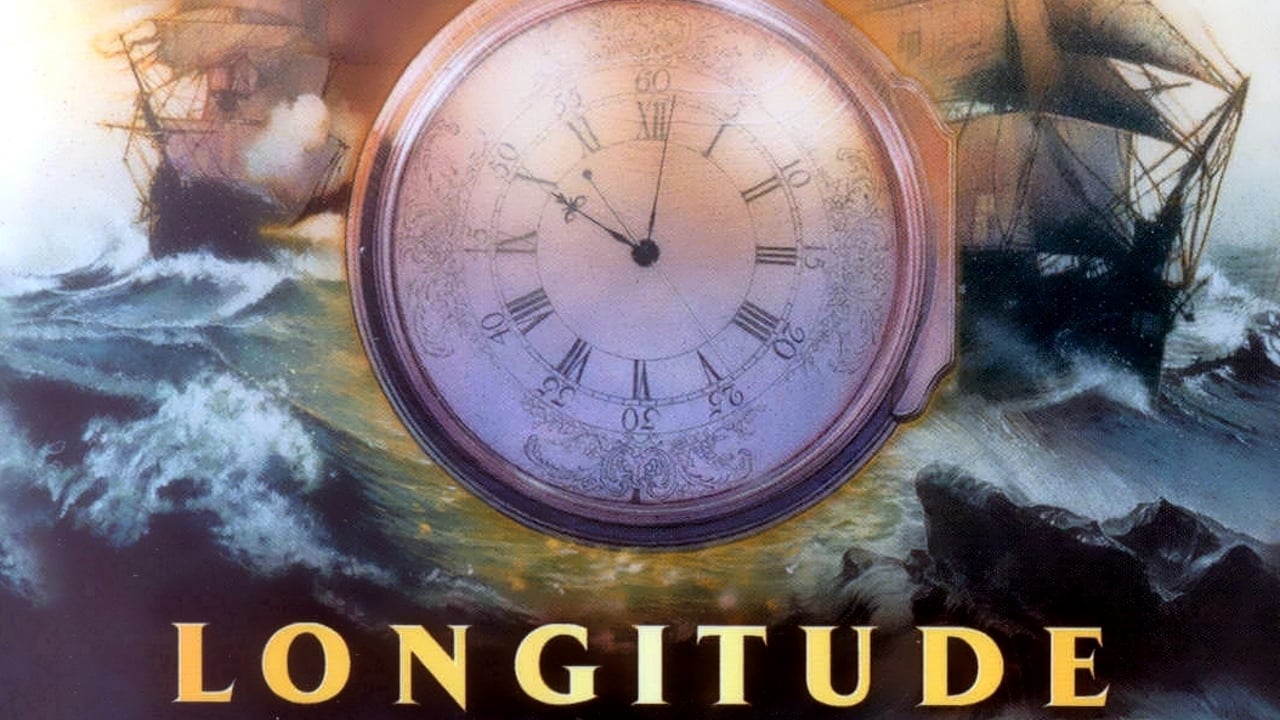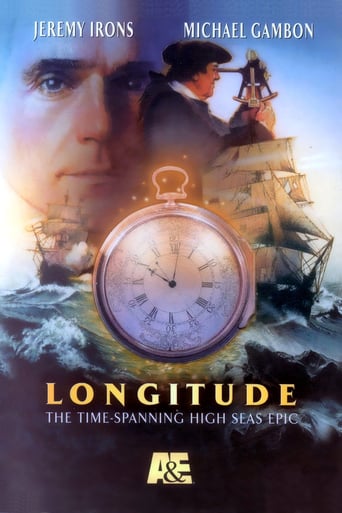Robert J. Maxwell
This feature film is pretty shocking, considering the subject. It opens with an able seaman in His Majesty's Navy being hanged from the yardarm in 1707 for keeping an independent log of the ships position, whose figures disagreed with those of the captain by some ninety miles. Really. And then they cut down the body and it falls to the deck with a plop. The captain's reckoning was off and the seaman's was right but it doesn't matter. Latitude at sea, that is, degrees north and south, is easy to determine. These are the lines that run east and west along the globe. If the north star, Polaris, is on the horizon, you're at the equator. If Polaris is directly overhead, you're at the north pole. By measuring the elevation of Polaris you can fix your latitude by degrees. Longitude -- the lines that run up and down on a map and indicate degrees east and west -- is much more difficult because it requires an accurate timepiece, one that doesn't depend on a pendulum. (Ships rock and roll.) Well, Britain is an island, and a seafaring nation, about to launch its colonial period. They need navigation more accurate than dead reckoning. The merchant ships and men of war need to know where they are and where they are going. That is, it's usually better to sail around the Cape of Good Hope rather than into it. So the government offers a prize for anyone who devises a solution to the problem. Some of the devices offered depend on using magic on wounded dogs and are pretty funny.Carpenter Michael Gambon devises a clock the size of a refrigerator that he hopes is immune to the ship's movement and he's given permission to try a test run back and forth to Lisbon. The results are inconclusive and he continues with his work, running out of money and always running up against the Royal Society and its preference for "scientists" over "carpenters" -- scientists who believed that the pineal gland was the seat of emotions.Meanwhile, there are rather abrupt cuts to the 1930s, where we see Jeremy Irons trying to reconstruct Gambon's antique clocks, now all weathered and stuck. It's frustrating work. Irons can't get much help either because he's been divorced and because he suffered from a nervous breakdown, as it was called in the 30s. It's irritating too, as Irons proceeds to duplicate Gambon's work, to find that when he had a problem, Gambon attached a corrective device. When that proved not accurate enough, he attached still another corrective device, until layer upon layer of corrective devices made the whole mad construction impossible. Still, in their parallel universes, both Gambon and Irons persist. These cuts, by the way, may sound more confusing than they are. Once the characters and settings are established, there's no problem.It's reasonable to ask how much a viewer needs to know about a clock's innards before he can follow developments. It's easy. You only need to know the elements of potential energy, torque, bevels, a folio balance and verge escapement, a high ratio weight gear train, parallax, the piezoelectric effect, the Zeigarnik effect, Ohm's law, the Purkinje effect, the properties of subatomic particles, the genitalia of Saurians, Marbe's law, Murphy's law, and who Christiaan Huygens was. Actually, you don't need to know anything about clocks except that if they're accurate enough they can tell longitude. It demands nothing but patience. There's even an exchange of shots at sea with a Spanish privateer to liven things up.Both Gambon, who plays John Harrison, and Jeremy Irons, who plays Rupert Gould, are balked at almost every turn, not only because of the nature of the technical problems they face but because of what might be called paradigmatic inertia. When you are dealing with a Royal Society that believes that curing illness requires bleeding the patient, you're going to have a hard time convincing them that a watch the size of a small frying pan will tell longitude. And in Iron's case, he was trying to find money in a country that was recovering from a depression and simultaneously preparing for war.Both are successful in their pursuits. Gambon's character worked on his time pieces for fifty years and was finally awarded the prize he sought, not from the board of scientists but from Parliament. He was eighty years old. Iron's character recovered and became a well-known media figure specializing in science, and was eventually made curator of a prominent museum. All of these struggles are fleshed out and non-trite. What they led to is the reason all the world today measures its time according to "Greenwich Mean Time" or GMT.In a way the program resembles an afternoon soap opera except that it has a much better budget, the writing and dialog are light years advanced, the characters are more flesh than cardboard, the direction is more sensitive and trusting of the viewer, the central theme isn't love but a problem that exists in nature, and the acting is exquisite. Both Irons and Gambon are nearly perfect in their entirely different ways -- Gambon proud and blustery, Irons neurotic and timid.Irons is required to enact another breakdown of an unspecified source. It looks like a manic episode. In the 30s, there was no way of dealing with it except to knock the patient out with narcotics. Without that, you have a real-life "raving lunatic" on your hands. Fortunately, the extreme episodes tend not to last too long. The hospitalized Irons gets a radiantly beautiful nurse, Lucy Akhurst. They always get good-looking nurses in the movies. She's not only good for him; she's good to him.
SnoopyStyle
In the 18th century, latitude is readily observable but longitude is nearly impossible. The inability to find longitude is the difference between life and death. After one particularly devastating loss, the government offers £20k for a practical solution. The solution lies in a marine chronometer that can work on the rolling seas. Clockmaker John Harrison (Michael Gambon) creates such a clock as he struggles to prove his invention's accuracy. In post-WWII, Rupert Gould (Jeremy Irons) becomes obsessed with finding Harrison's clocks and restoring them to their working conditions.It's an eye opening slice of scientific and exploration history. It seems like such an unsexy slice of history but it's such an important one. Surprisingly, this movie makes it compelling. It's a great way to see into another era. Harrison is the quintessential underdog and Michael Gambon does a great job making him a socially awkward man. There is a compelling competition with the scientific old guard. Jeremy Irons' modern story isn't quite as compelling. Overall, this is very enlightening history lesson and a well-made one at that.
Sigmoid Flexure
All great stories deal with conflict and overcoming difficulties. The vast majority of films that are produced thesedays feature heros who triumph based on who is a bigger bad ass or has got the biggest guns or bombs. Here is a film that has virtually no 'action' other than a few cannons fired and a lashing or two during the parts at sea, but is filled with the sort of tension and drama that keeps the viewer constantly involved.If you enjoy intelligent movies, then you should definitely seek this film out. It sounds dreadfully boring if you read the plot summary, but it isn't. It is wonderfully written and produced and contains much light humor as well, making it truly entertaining.One film that it reminded me of is "Master and Commander" because of the similar scenes of the British navy and the theme of the struggle of science and progress in the face of war and politics with intelligence and perseverance winning out in the end.The interwoven story of Rupert Gould is just as interesting and provides an artistic counterpoint to the main story. Again, we have the story of a man who continues with his work in spite of numerous obstacles of the most serious magnitude because he knows that the world will be a better place as a result of that work.The film is long and you should wait until you have enough time to sit down and watch it through to the end because once you begin you will have difficulty turning it off.
chip98
Long, but worth it! A blessed antidote to MTV's Tom Green and the rest of the scumbag-chic that passes for culture these days. Based on the brilliant history of the same name by Dava Sobel.In the days when ships measured themselves by yardage of sail and bank of cannon, knowing your north-south latitude was easy. Finding your east-west longitude however (and keeping your ship off the reefs) was hit-and-miss. That could get you killed. The cure was to know the time in London, precisely, but keeping time accurate on a rolling ship was tougher than keeping milk fresh; pendulum clocks need stable ground, and pendulum clocks were all they had.Queen Anne (Br., 1665-1714) had another idea: a 20,000 pound-sterling prize to anyone who had a solution. Problem was, no one expected a country carpenter cum-clockmaker to do it. John Harrison (Michael Gambon) was that carpenter, and it became *his* problem--a three-decades-long problem. It would also pose one for Rupert Gould (Jeremy Irons) two centuries later, as a marriage-busting, sanity-breaking obsession over restoring Harrison's neglected prototypes: clocks that could keep time at sea better than the quartz-timed digital you might be wearing now."Longitude" weaves seamlessly--almost--between the two eras, tracking the exertions and miseries of John Harrison and Rupert Gould with the same kind of synchronicity Harrison spent half his life pitching to astronomers who had scarce respect for the tinkerings of a hayseed. Michael Gambon's passionate performance as John Harrison is truly Oscar-calibre, eclipsing Irons--but only because the tunnel-visioned Rupert Gould is hardly a vehicle for the memorable. Too bad this was "only" a TV mini-series. As a theatrical release it would have lent due reknown to a scarce-remembered true epic of genius.Watch this when you get the chance. Then go punch Tom Green in the nose.

